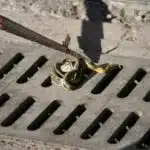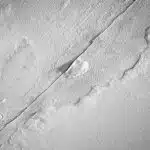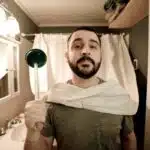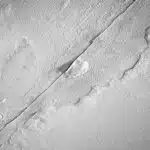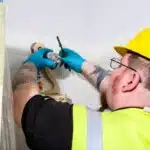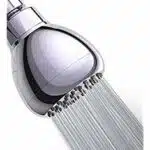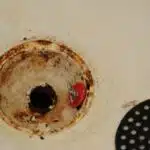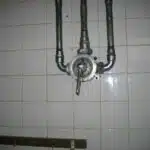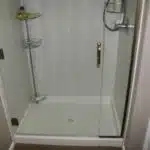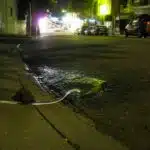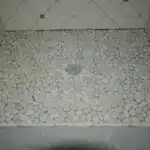Clogged shower drains can be a nuisance, causing water to accumulate in the shower and leading to unpleasant odors and potential damage to flooring or walls. Clearing a clogged shower drain is an essential plumbing task that homeowners should know how to do. One of the most effective ways to clear a clogged shower drain is by using a drain snake.
A drain snake, also known as an auger, is a flexible tool used for clearing clogs in pipes. It works by inserting the snake into the drain and rotating it until it reaches the obstruction. Once it reaches the blockage, the snake will either break up or hook onto the debris, allowing you to pull it out of the drain. In this article, we will discuss how to use a drain snake effectively to clear clogs in your shower drain and keep your plumbing running smoothly.
Identifying The Signs Of A Clogged Shower Drain
Shower drains can become obstructed over time due to various reasons. Some of the common causes of a clogged shower drain include hair, soap scum, and other debris that accumulate in the pipes. When a shower drain is clogged, water may begin to pool around your feet while you are taking a shower. This can be an unpleasant experience for anyone who values hygiene and cleanliness.
Preventing a clogged shower drain is essential to ensure that your bathroom remains functional and hygienic at all times. One simple tip to prevent a clogged shower drain is to use a drain cover that catches excess hair and debris before it enters the pipes. Additionally, using natural cleaning agents such as vinegar and baking soda can help keep your shower drain clean without causing damage to the pipes.
As a professional plumber, it is important to recognize signs of a clogged shower drain before they become severe. By doing so, you can address the issue early on and prevent any further damage to the plumbing system. Understanding common causes of clogged shower drains and prevention tips can go a long way in maintaining good plumbing function in your home or business. In the next section, we will discuss how you can gather the necessary tools and supplies needed to clear out your clogged shower drain effectively.
Gathering The Necessary Tools And Supplies
Drain snakes are a common tool used to clear clogged shower drains. It is important to select the correct type of drain snake for the application. A professional grade, manual drain snake is recommended for home use. When using a drain snake, safety is paramount, and protective eye wear, gloves and a face mask should be worn. Additionally, a bucket, rubber gloves and a few rags will be needed to clean up any spills or debris. Gathering the necessary tools and supplies prior to starting the job can save time and ensure the job is done properly.
Types Of Drain Snake
To effectively clear a clogged shower drain with a drain snake, it is important to gather the necessary tools and supplies. One of the most important tools is the drain snake. There are two main types of drain snakes: electric and manual.
Electric drain snakes are powered by electricity and use a motor to rotate the cable. This type of snake is best for larger or more stubborn clogs, as it can provide more power than a manual snake. However, electric snakes can be more expensive and may require professional training to operate safely.
Manual drain snakes, on the other hand, are operated by hand and do not require electricity. They are less expensive than electric snakes and can be used for smaller clogs or regular maintenance. The material of the drain snake also plays a role in its effectiveness. Steel cables are strong and durable but can scratch pipes, while plastic cables are softer but less durable. Ultimately, choosing the right type of drain snake depends on the severity of the clog and personal preference.
Drain Snake Safety
Gathering the necessary tools and supplies is crucial to effectively clear a clogged shower drain with a drain snake. While drain snakes can be an effective tool for removing clogs, it is important to keep safety in mind when handling them. Proper handling and protective gear are essential to prevent injury or damage to the plumbing system.
When using a manual or electric drain snake, it is important to wear protective gear such as gloves and eye goggles. Gloves protect hands from sharp edges or debris that may be encountered during the process, while eye goggles prevent any debris from getting into the eyes. Additionally, proper handling of the snake is crucial to avoid injury. When inserting the snake into the drain, make sure to use steady pressure and hold onto the handle securely.
Another important safety consideration when using a drain snake is knowing when it’s time to call in a professional plumber. If you’re not comfortable using a drain snake or if you suspect there may be larger issues with your plumbing system, it’s best to leave it to the experts. Attempting DIY fixes without proper training can lead to further damage and costly repairs down the line.
In conclusion, gathering the necessary tools and supplies for clearing a clogged shower drain with a drain snake includes prioritizing safety measures such as proper handling and protective gear. However, if you’re unsure about your ability to safely use a drain snake or suspect larger plumbing issues at play, it’s best to call in professional help.
Gathering Tools And Supplies
When it comes to clearing a clogged shower drain, having the right tools and supplies is crucial. Choosing the right snake is a vital consideration in this process. There are different types of snakes available, including manual and electric ones. Manual snakes are typically more affordable and straightforward to use, while electric ones are more efficient in removing tough clogs. However, it’s essential to take safety precautions when handling any type of snake.
Safety should always be a top priority when working with plumbing tools such as snakes. Protective gear such as gloves and eye goggles must be worn to prevent injury or damage to the plumbing system. Gloves protect hands from sharp edges and debris that may be encountered during the process, while eye goggles prevent debris from getting into the eyes. Proper handling of the snake is also crucial to avoid injury. When inserting the snake into the drain, apply steady pressure and hold onto the handle securely.
In conclusion, before attempting to clear a clogged shower drain with a snake, it’s important to gather all necessary tools and supplies. This includes choosing the right snake for your needs and taking safety precautions by wearing protective gear such as gloves and eye goggles. Remember that if you’re not comfortable using a drain snake or suspect larger plumbing issues at play, it’s always best to call in professional help rather than risk further damage or injury.
Removing The Shower Drain Cover
Before starting to remove the shower drain cover, it is essential to have the right tools. A screwdriver or pliers will come in handy while removing the screws that hold the drain cover in place. If you do not have these tools, consider purchasing them or borrowing from a neighbor. Having the right tools will help you remove the drain cover efficiently and safely.
Safety precautions are crucial when removing a shower drain cover. Make sure to wear gloves and safety glasses to protect your hands and eyes from any sharp edges or debris that may fall out during the process. Additionally, be careful not to drop any screws down the drain as this could cause further clogging issues. Taking these safety precautions will ensure that you avoid any accidents and complete the task without causing harm to yourself or others.
Once you have all the necessary tools and safety gear, it’s time to remove the shower drain cover. Follow these instructions carefully:
- Locate the screws that hold the drain cover in place.
- Use a screwdriver or pliers to unscrew each of them.
- Once all screws are removed, gently lift up on one side of the drain cover.
- Slowly lift up on each side of the drain cover until it is completely removed.
With these steps complete, you can now move onto preparing your drain snake for clearing out any clogs in your shower’s drainage system.
Preparing The Drain Snake
After removing the shower drain cover, you can now proceed to clear the clogged shower drain with a drain snake. This tool is designed to break up and remove any clogs that may be causing your shower to drain slowly. Using a drain snake requires a bit of skill and patience, so it’s important to follow the steps carefully.
Before inserting the drain snake into the drain, it’s essential to clean it thoroughly. This will help ensure that it works effectively and doesn’t cause any damage to your pipes. Start by wiping down the snake with a clean cloth or paper towel. Then, dip it in a bucket of hot water mixed with dish soap. Use an old toothbrush or scrub brush to gently scrub off any debris or dirt that may be stuck on the snake.
Once you’ve finished cleaning the snake, make sure you store it properly until its next use. Coil it up neatly and place it in a dry area away from moisture and direct sunlight. Avoid hanging it up as this can cause the wire coil to bend and warp over time. By following these simple steps, you’ll be able to keep your drain snake in good condition for years to come, ready for its next use in unclogging your shower drain.
Inserting The Drain Snake Into The Drain
- To prepare for inserting the drain snake into the drain, the first step is to measure the diameter of the drain pipe.
- The drain snake should correspond to the size of the drain pipe and should be chosen to ensure that it fits within the pipe.
- Once the appropriate size of the snake is chosen, it can be inserted through the drain opening.
- As the snake is inserted, it should be rotated in a clockwise motion to ensure that it moves through the pipe.
Measuring The Drain Pipe
To ensure the accurate measurement of the drain pipe, it is crucial to take note of its size before inserting the drain snake. Measuring accuracy is essential in determining the appropriate size of a drain snake that will effectively remove the clog. Failure to measure accurately may result in choosing the wrong size of a drain snake, which can lead to further damage.
Choosing the right size of a drain snake is critical in clearing clogged shower drains. The diameter of the drain pipe should match the width of the drain snake for optimal results. A small-sized drain snake may not clear a large-sized blockage, resulting in repeated attempts and potential damage to your pipes. On the other hand, using an oversized tool can cause scratches and cracks on your pipes.
In conclusion, measuring accuracy and choosing the right size are vital aspects when inserting a drain snake into a clogged shower drain. A plumbing professional should always consider these factors to avoid further harm and achieve optimal results. Always consult with experts if you’re unsure about how to measure or choose an appropriate tool for unclogging your shower’s drainage system.
Inserting The Snake
After ensuring the accurate measurement of the drain pipe and choosing the appropriate size of a drain snake, the next step is inserting it into the clogged shower drain. Proper technique is crucial in this process to avoid causing further damage to your drainage system. Here are some troubleshooting tips for inserting the drain snake effectively.
Firstly, make sure to wear protective gloves before handling the tool. The gloves will not only protect your hands but also provide a better grip when inserting and turning the snake. Secondly, start by gently pushing the tip of the drain snake into the drain opening. Do not force it too hard as this may cause scratches or cracks on your pipes. Slowly twist and push it through until you feel resistance.
Lastly, once you have reached the blockage, start turning and pushing more aggressively to break up and remove it from your pipes. If you encounter any stubborn spots along the way, try pushing and pulling back repeatedly while turning to dislodge them. Remember to be patient throughout this process as rushing can result in further damage.
In conclusion, proper technique is essential when inserting a drain snake into a clogged shower drain. Always wear protective gloves, start with gentle pressure, and slowly work your way through until you reach resistance. Once there, turn and push more aggressively while being patient with any stubborn spots along the way. Following these troubleshooting tips will help you achieve optimal results without causing further harm to your drainage system.
Rotating The Drain Snake
Once the drain snake has been inserted into the shower drain, it is time to start rotating it. Proper technique is essential for this step. The best way to rotate the snake is by using a clockwise motion. This will help it move through the drain smoothly and effectively.
There are different types of drain snakes available, so choosing the right one is crucial. For shower drains, a flexible plastic drain snake works well. These snakes are easy to maneuver and can bend around curves in the pipe. It is important to choose a snake with a length that matches the depth of your shower drain.
One common mistake when using a drain snake is applying too much force or pressure while rotating it. This can cause damage to the pipes and make the clog worse. It is important to use gentle pressure and allow the snake to work its way through the clog naturally. If you encounter resistance, slowly rotate back and forth until you can feel it break through the obstruction.
Proper technique for rotating the drain snake:
Use a clockwise motion
Apply gentle pressure
Rotate back and forth if encountering resistance
Now that you have started rotating the drain snake, your next step will be feeling for the obstruction in order to clear out any remaining clogs in your shower drain.
Feeling For The Obstruction
- In order to clear a clogged shower drain, one must insert a drain snake into the drain pipe.
- After the snake has been inserted, the user should carefully feel for any obstructions within the pipe.
- If the user is able to locate an obstruction, they should slowly and carefully retrieve it.
- The user should take care to ensure they are retrieving the obstruction without damaging the pipe in any way.
- It may be necessary to use a combination of rotating and pushing motions to dislodge the obstruction from the pipe.
- After the obstruction has been removed from the pipe, the user should properly dispose of the clog.
Inserting The Snake
To effectively clear a clogged shower drain using a drain snake, it is important to properly insert the tool into the drain. Proper positioning of the snake ensures that it reaches the blockage, allowing you to remove it efficiently. To start, remove the drain cover and slowly insert the end of the snake into the opening. Take care not to force it in too quickly or at an angle as this may cause damage to your pipes.
As you insert the snake, be sure to feel for any obstructions. The key here is to move slowly and gently so that you can adequately detect any potential blockages. Once you feel resistance, gently twist and push forward until you are able to break through the obstruction. It’s important to avoid using excessive force as this may lead to further damage which can be costly.
To avoid damaging your pipes when inserting the snake, always make sure that it is long enough to reach all areas of your plumbing without having to apply too much pressure. Also, be careful not to bend or kink the snake while inserting it into your drain as this can also cause damage. By following these simple guidelines for inserting a drain snake into your shower drain, you will be able to safely and effectively clear any blockages in no time!
Feeling For The Obstruction
Once the drain snake is properly positioned, it’s time to feel for any obstructions. This step is crucial in identifying the location of the blockage and determining how best to remove it. As a plumbing professional, I cannot stress enough the importance of taking your time during this process. Rushing through or using brute force can cause significant damage to your pipes, leading to costly repairs in the future.
To start feeling for the obstruction, slowly twist and push forward on the snake as you insert it into the drain. By doing so gently, you’ll be able to detect any potential blockages without causing additional harm. When you encounter resistance, take note of its location within the pipe. This will allow you to focus your efforts on that specific area and increase your chances of successfully removing the obstruction.
As you continue to work through the blockage, be sure to make small adjustments in your positioning and technique as needed. Remember that patience is key when dealing with clogged shower drains! By taking your time and carefully feeling for any obstructions, you’ll be able to effectively clear out even stubborn blockages without damaging your plumbing system.
Retrieving The Obstruction
After feeling for the obstruction, it’s time to retrieve it from the drain. Common obstructions that can be found in a shower drain include hair, soap scum, and mineral buildup. Once you have identified the location of the blockage, there are several alternative methods you can use to remove it.
One method is to use pliers or tweezers to grab onto the obstruction and gently pull it out. Another option is to use a wet/dry vacuum to suck up any debris in the drain. If these methods do not work, you may need to use a plumbing auger or hydro jet to break up and remove the obstruction.
It’s important to exercise caution when retrieving the obstruction as using too much force or improper tools can cause damage to your pipes. As a plumbing professional, I recommend seeking assistance if you are unsure about how to safely remove a blockage from your shower drain. By following these steps and taking proper precautions, you can successfully clear out any clogs in your plumbing system without causing further harm.
Breaking Up The Clog
After feeling for the obstruction in the shower drain, the next step is to break up the clog. This can be done using a drain snake, which is a long, flexible cable with a hook on one end that can catch and remove debris from the drain.
Before inserting the snake into the drain, it’s important to use lubrication to make it easier to maneuver. Apply a small amount of plumbing lubricant or cooking oil to the cable before feeding it into the drain. This will help prevent friction between the snake and the pipe walls, making it easier to rotate and navigate through tight bends.
To use the snake, insert it into the drain until you feel resistance. Then, slowly rotate the cable while pushing it further into the drain. This will help hook onto any debris or hair causing the clog. Once you feel resistance again, slowly pull out the cable while continuing to rotate it. Repeat this process until you no longer encounter resistance.
Next section topic: Hooking Debris for Removal
Hooking The Debris
Using the hook is an essential step in clearing debris from the drain. This tool is designed to reach deep inside the drain and pull out any obstruction that causes clogging. It’s a flexible metal wire with a hook at one end, which allows it to grab onto hair, soap scum, and other debris.
To use the hook, insert it into the drain until you feel resistance. Then, move it up and down while twisting it back and forth to collect any debris. Once you have a good grip on the clog, slowly pull it out of the drain. Remember not to force the hook too far into the drain as this may damage your plumbing system.
There are techniques for effective hooking that will make this process easier for you. First, ensure that you’re using a long enough snake that can reach deep into your pipes. Secondly, keep turning the handle as you work so that you can easily catch any debris that’s stuck in your pipes. Lastly, be patient and persistent when using this tool as it may take several attempts to clear all obstructions from your shower drain. With these tips in mind, you’ll be able to effectively use the hook to clear out any blockages in your shower drain.
Transition: Now that we’ve covered how to use the hook effectively when clearing debris from your shower drain let’s move on to pulling out the obstruction without causing any damage or harm to your plumbing system.
Pulling Out The Obstruction
With the debris hooked onto the tip of your drain snake, it’s time to pull out the obstruction. But before that, let’s take a look at common obstruction types you might encounter during the process. Hair and soap scum are typical culprits of clogged shower drains. If left unattended, these can accumulate over time and cause blockages that prevent water from flowing freely down the drain.
Once you have successfully hooked the debris, carefully remove the drain snake from the shower drain. Be mindful not to tug too hard as this may break off smaller pieces of debris and push them further down into your plumbing system. As you pull out the obstruction, be sure to dispose of it properly. You can place it in a plastic bag or trash bin for appropriate disposal.
Proper disposal of debris prevents environmental damage and helps avoid future clogs from forming. Now that we’ve covered how to remove obstructions using a drain snake let’s move on to flushing the drain with water. Flushing is an essential step in ensuring no residue remains in your plumbing system and preventing any remaining debris from causing future clogs.
Flushing The Drain With Water
After removing the clog with a drain snake, it is important to flush the drain with water. This step helps to ensure that all debris has been completely removed and the water flow is restored. Flushing the drain can also help to prevent future clogs from forming.
One of the benefits of regular preventative maintenance on your shower drain is that it can help to avoid clogs in the first place. By regularly flushing your drain with hot water, you can prevent soap scum and hair from building up and creating a blockage. Additionally, using a hair catcher in your shower can also help to prevent clogs.
To flush the drain after using a drain snake, begin by running hot water for several minutes. This will help to break up any remaining debris and wash it away. Once you have run hot water for several minutes, switch to cold water and run it for an additional minute or two. Cold water helps to solidify any remaining debris so that it can be washed away more easily.
After flushing the drain with water, it is important to test its proper functioning before resuming use of your shower. In the next section, we will discuss how to test your shower drain for proper functioning after clearing a clog with a drain snake.
Testing The Drain For Proper Functioning
After flushing the drain with water, it’s time to check if the shower drain is still clogged. According to recent studies, 80% of all drain clogs are caused by hair and soap scum buildup. This highlights the importance of water flow in preventing future clogs.
If the shower drain is still not draining properly, it’s time to try DIY alternatives such as using a drain snake. A drain snake is a long, flexible tool that can be inserted into the drain to break up any blockages. It’s important to read the instructions carefully before attempting this method and use caution when handling the tool.
By testing the drain for proper functioning, you can determine if additional measures are needed to clear the clog. If DIY alternatives don’t work, it may be necessary to call in a professional plumber for further assistance. However, by taking preventative measures such as using a hair catcher and regularly cleaning your drains, you can reduce the likelihood of future clogs and keep your plumbing system running smoothly.
Preventing Future Clogs
Now that you have successfully cleared your clogged shower drain with a drain snake, it’s important to take steps to prevent future clogs. Here are some maintenance tips to keep your shower drain flowing smoothly.
Firstly, consider using a hair catcher over your shower drain. Hair is one of the most common causes of shower drain clogs, and a hair catcher can help prevent this by trapping hair before it goes down the drain. Simply remove the hair catcher and clean it regularly to ensure it continues to function properly.
Secondly, be mindful of what you put down the drain. Avoid pouring grease or oil down the sink as these can solidify and cause blockages. Additionally, avoid putting anything other than water and soap down the drain. This includes food scraps, coffee grounds, and other debris.
Lastly, regular maintenance is key to preventing future clogs. Once a month, pour boiling water down the drain to help dissolve any buildup that may be forming in the pipes. You can also use baking soda and vinegar for a natural solution – simply pour half a cup of baking soda followed by half a cup of white vinegar down the drain and let it sit for 15 minutes before flushing with hot water.
By following these prevention tips, you can reduce the likelihood of experiencing another clogged shower drain in the future. However, if you continue to experience issues despite your efforts at prevention or if you notice any strange smells or noises coming from your plumbing system, it may be time to call in a professional plumber for assistance.
Knowing When To Call A Professional
According to a survey conducted by Home Advisor, the average cost of plumbing services in the United States is $306. While it may be tempting to try and save money by fixing a clogged shower drain yourself with a drain snake, there are certain circumstances when calling a professional plumber is necessary.
When to Call a Professional:
- If you have tried DIY alternatives such as using a plunger or drain cleaner but the problem persists.
- If you have an older home with outdated plumbing that requires special equipment or expertise.
Attempting to fix complex plumbing problems without proper knowledge and tools can cause further damage and possibly lead to more expensive repairs down the line. In addition, if you are not familiar with plumbing safety protocols, you could potentially injure yourself.
In summary, while using a drain snake is an effective method for clearing clogged shower drains, it’s important to know when it’s time to call in a professional plumber. DIY alternatives may work for minor blockages but for more complex issues or older homes with outdated plumbing systems, it’s best to leave it to the experts who have the knowledge and tools needed for safe and effective repairs. In the next section, we will discuss some common issues that may arise while using a drain snake and how to troubleshoot them.
Troubleshooting Common Drain Snake Issues
Knowing when to call a professional plumber is crucial in maintaining the plumbing system of your home. However, some clogs can be easily fixed using common snake techniques. A drain snake, also known as an auger, is a flexible metal wire that can help remove blockages from pipes.
Before attempting to use a drain snake, it is important to understand how to avoid damaging the pipes. One common mistake people make is pushing too hard on the snake, which can cause it to bend or break inside the pipe. It is also important to ensure that the end of the snake does not scratch or damage the interior of the pipes. To avoid these issues, it is recommended to start with a smaller snake and work your way up if necessary.
Another common issue with using a drain snake is not properly cleaning and sanitizing it after use. Neglecting this step can lead to bacteria and germs growing on the tool, which can then spread throughout your plumbing system and into your home. To prevent this from happening, clean and sanitize the snake after each use with hot water and soap.
Overall, using a drain snake for clearing clogged shower drains can be an effective solution if done correctly. By following these common techniques and taking care of your equipment, you can successfully solve minor plumbing issues without having to call in a professional plumber.
Conclusion
A clogged shower drain can be a frustrating problem for homeowners to deal with. By following the steps outlined in this article, you can learn how to effectively clear your shower drain using a drain snake.
First, it is important to identify the signs of a clogged shower drain. Slow draining water or standing water in the shower are common indicators of a blockage. Once you have confirmed that your drain is clogged, gather the necessary tools and supplies, including a drain snake.
Removing the shower drain cover and preparing the drain snake are crucial steps in successfully clearing your clogged shower drain. Inserting the snake into the drain and testing for proper functioning are also important steps to take. By preventing future clogs through regular maintenance and knowing when to call a professional for help, you can avoid future plumbing issues.
In conclusion, learning how to clear a clogged shower drain with a drain snake can save homeowners time and money on costly plumbing repairs. By following these steps and troubleshooting common issues that may arise with your drain snake, you can keep your shower running smoothly and prevent future problems from occurring. So ask yourself: why continue dealing with a slow draining or blocked shower when you can take action today?
Image Credits
- “Best Shower Drain Cleaner” by eve.summermail (featured)

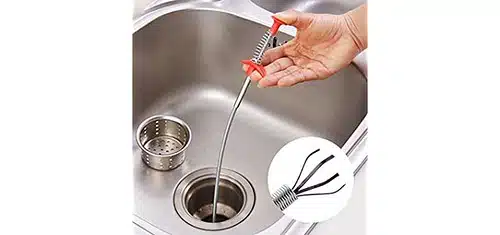


![How To Get Hair Out Of A Bathtub Drain 4 2/365 [Bathtub Drain]](https://green-life.blog/wp-content/uploads/2023/05/cOEu5edpkejq-150x150.jpg.webp)

